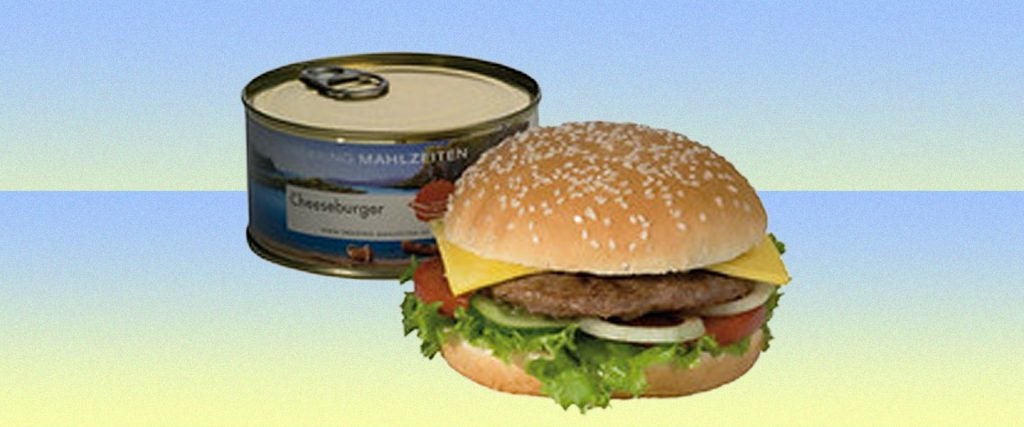A couple years ago, Jack Baron found himself sitting face-to-face with a food item so “bizarre looking that I just sat there and marveled at it.” That wet, mostly-colorless hunk of food was the infamous “Cheeseburger in a Can,” a product made by the “The Adventure Company” based out of Germany.
Technically called the “Trekking Burger,” The Adventure Company advertised the cheeseburger in a can as a hearty meal for hikers or survivalists. “It’s a full cheeseburger — meat, bun, cheese, pickles, condiments — all smushed into a can,” recalls Baron, now a registered dietitian in New York. “And since they were intended to be backpacking or trail food, they have a high caloric value and stay safe to eat for a long time.”
Per The Adventure Company’s website, the cheeseburger in a can is no longer available for purchase. But soon after its inception in 2008, the mysterious oddity became a perfect novelty item. And it attracted all sorts: morbidly curious foodies like Baron as well as food bloggers and content creators on YouTube, who made countless taste-test videos, picking apart the cheeseburger in a can’s soggy ingredients.
Putting the taste testing to the side, was the canned cheeseburger actually safe to eat? According to Darin Detwiler, a food historian and professor of food policy and regulatory compliance at Northeastern University, that’s a tricky question. “The cheeseburger in a can was a heavily processed ‘commercially packaged good,’” he says, “in which a pre-cooked and highly preserved meat patty was placed between a highly preserved bun along with bits of pickles, onions, condiments, etc.”
This means that as long as the can remained in good shape, the cheeseburger inside it would have a long shelf life. “But it wasn’t a ready-to-eat product, as it needed to be cooked to a proper temperature in order to prevent a foodborne illness,” Detwiler continues. “So once users peeled off the label, boiled the unopened can as per the instructions, they could then open the can, remove the product and eat it.”
Unsurprisingly, both Detwiler and Baron confirm that the product didn’t actually look like a “real,” or at the very least appetizing, cheeseburger. “It looked more like a bun filled with what one assumes is the ingredients,” Detwiler says.
“It actually held its structural integrity fairly well in the can,” Baron adds. “But it came out looking kind of like a mushy gas station cheeseburger, just much more oily and with less color.”
As for what a canned cheeseburger tastes like? “The bread was very soggy and the meat has a very spongy, almost unnaturally soft texture,” Baron recalls. “It’s hard to explain, but the best I can do is that it was just unnaturally spongy, like some nondescript matter that’s neither solid nor liquid.”
“It was also very salty,” he continues. “Very, very salty. And the cheese, pickles and other condiments, if you tasted them at all, just sort of blended together under the saltiness.”
So neither Baron or Detwiler are scouring the internet to find a stray cheeseburger in a can for sale anytime soon. But, for those who do want to get their hands on the canned burger, Detwiler argues it won’t be long until another company makes an attempt.
Sure, canned meat has long been a pariah to public health, he says, but consumer demand for ready-to-eat food is at an all-time high. “While supply chains are being stressed still after the pandemic, along with food costs rising, more people have food and survival on their mind today than they have over the past century,” he concludes. “So no, I don’t think that the days of canned cheeseburgers are over.”

